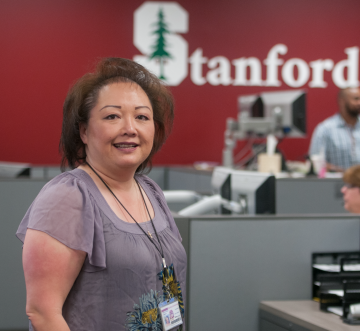OSC: Where Calls are Answered With Care
10:50 a.m. - “I’m trying to reach Student Services, could you please connect me?”
6:38 p.m. - “I live in Roble Hall and I’m locked out of my room, can you send someone over?”
3:07 a.m. - “This is Susan at Packard, we have an emergency and need a surgeon ASAP.”
This is just a small glimpse into a normal workday for the 34 staff members in University IT's Operator Services Call Center (OSC), who handle around 3,000 calls like this each and every day.
 OSC Manager, Pam Miller.
OSC Manager, Pam Miller.
It’s not too often that we stop to think about the people on the other end of the phone line when we call the main line at Stanford, or say, get stuck in an elevator and pick up the phone to call for help. However, after talking with OSC team members and manager Pam Miller, it’s clear that these folks are among the unsung heroes of Stanford.
The OSC team’s work spans across Stanford University, Stanford Health Care, and Stanford Children’s Health, as they manage the main phone lines for each organization. They also support disaster response for the university and healthcare campuses, and answer after-hours calls for R&DE, Environmental Health & Safety, the Faculty Club, and more.
As the central call center on campus, the team handles about 40,000 outgoing calls in addition to 90,000 incoming calls each month, while working behind the scenes 24 hours a day, seven days a week, 365 days a year to support the health and welfare of the Stanford community.
Code calls
The team’s primary focus – which comprises about 90 percent of their work – is supporting the hospitals by dispatching emergency calls, fielding informational calls, providing overhead paging services within the hospital, and coordinating after-hours paging to the doctors who are on call.
“The work we do is so important, it’s so critical. At times, it’s life or death. There is no room for error,” Pam commented.
The most critical calls are “code calls,” which occur when there is an emergency at one of the hospitals. When someone is in need of immediate care – whether it’s a patient, visitor, expectant mother about to give birth, or any other person – the hospital staff can pick up any nearby phone in the hospital and dial 211.
This number routes into the call center, located on campus, and is identified by a special ring. From there, OSC operators must answer in two seconds or less, and ask a series of questions in order to dispatch it to the correct response team in the correct location, all in just a matter of seconds.
There are about 120 different algorithms to determine exactly how and to whom the call should be routed, which is dependent upon the unique circumstances of the situation.
“Taking a code call causes an adrenaline rush,” said Tony Villegas, OSC Lead. “It has to be right the first time.”
Quality service
Because of the critical nature of their work and the low margin for error, OSC team leaders spend much of their time focusing on how to maintain a high quality of service while also staying cost competitive.
“As a service provider we can never be comfortable, because there is always another team that thinks they can do it cheaper or better,” Pam said.
To address this challenge, they implemented a newfound mission: “Let’s Elevate Our Service.”
To do this, the team is focusing on education, training, and accountability initiatives, such as partnering with both hospitals to send all operators through the C-I-CARE Training Program. This acronym stands for connect, introduce, communicate, ask, respond, and exit. The program uses these touch points to train on elevating the patient experience.
They also initiated code refresher training, with a designated code trainer who provides intense, weeklong, one-on-one training for all operators.
“Our priority is to focus on quality – which is so important in life or death situations,” Pam said.
Committed staff
Despite these challenges and the stressful, “always on” environment, staff members don’t seem to be going anywhere anytime soon. And, the sense of pride within the department is high.
OSC staff member Tiana Ferriera said, “I feel honored and privileged to be part of this organization and Stanford University. And I know that what I do makes a difference in the lives of others.”
Other staff members seem to agree, as evidenced by their commitment to the job. The average length of service among the team is 16 years. The longest standing employee is John Childress who has been with the OSC since 1978.
“I have seen a lot of changes throughout the years,” John said. “Technology keeps evolving and my role and job has evolved as well. I love that every day at work is different with a new set of challenges and opportunities.”
DISCLAIMER: UIT News is accurate on the publication date. We do not update information in past news items. We do make every effort to keep our service information pages up-to-date. Please search our service pages at uit.stanford.edu/search.



